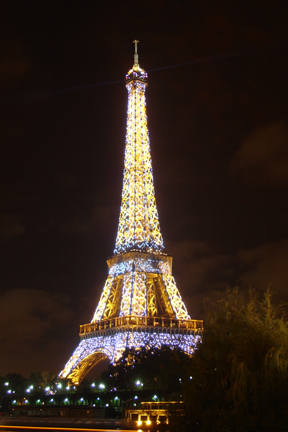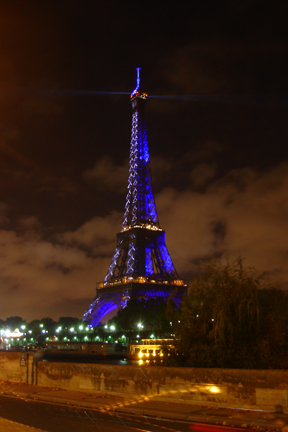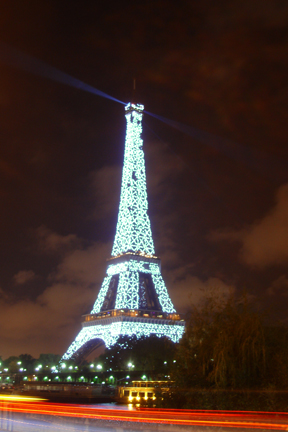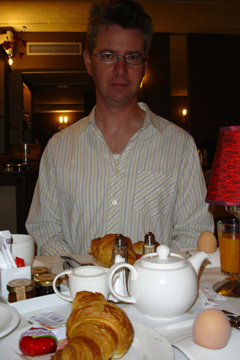
Sunday, November 8, 2009. In the morning, we had breakfast at the Eiffel Seine in the downstairs breakfast room and were among the first folks in there. The breakfast is very expensive- it's 14 euros which I think it pretty much nuts, but ours was included with our booking. You can have a couple different breakfast choices, but here is where upgrades cease to nickel and dime you the way they did at the Ambassadors- we had the full breakfast as part of our package, not the "partial" breakfast where we could upgrade to the full. I'm not sure at all why this pisses me off the way it does... I have long been mystified by french coffee- the way sun spots, shooting stars and people who can actually walk in 4 inch heels mystify me: how do they get it to taste so perfect a balance of robust coffee without bitterness and not an over-roasted bean in a ten-tastebud-radius? In the US we're forced to contend with crap like Peet's and Starbucks, gut-rotting crap sure to give you reflux and a bit of a grimace after each sip. This coffee never sacrifices its strength, and I'm not generally a fan of super strong coffee, without any bitterness. They serve it to you in a whole kettle, and they give you a side of lait which is always warm and steamed. I theorize that it's the warm milk that must make all the difference. I get by with minimal sugar in a whole pot, and it's just so good.

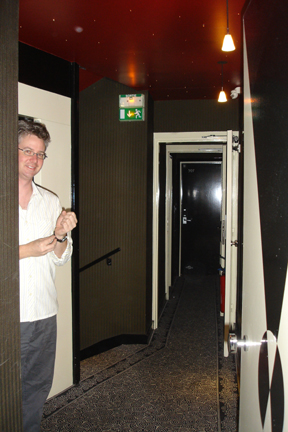 We
had a pot of coffee (two, really) and fabulous crisp and buttery croissant into
which I put a few slices of our lunch meat selection as well as some of the
selections of mini-cheeses we had available (babybel, camembert, goat and herb,
cream, processed french, gouda among others), yogurt, hard boiled eggs served
in these little wavy dishes solely made to hold an egg upright so you can eat
it soft-boiled style, sausages, other pastries, toast, cereal, fresh fruits
and chopped mixed fruit salad. It was wonderful, even if Larry don't look all
that happy about his breakfast in the photo. You can see our pot of coffee,
and the two little wavy dishes in which our boiled eggs are standing. Full on
breakfast, we left the modern and comfortable breakfast room for the room to
get together our things for the day's exploration. Larry carried my Paris guidebook
in his pocket, I carried his hat in my pocket, we had our money, maps, cameras.
All the necessary accoutrements which filled our pockets and made us feel stuffed
in our coats.
We
had a pot of coffee (two, really) and fabulous crisp and buttery croissant into
which I put a few slices of our lunch meat selection as well as some of the
selections of mini-cheeses we had available (babybel, camembert, goat and herb,
cream, processed french, gouda among others), yogurt, hard boiled eggs served
in these little wavy dishes solely made to hold an egg upright so you can eat
it soft-boiled style, sausages, other pastries, toast, cereal, fresh fruits
and chopped mixed fruit salad. It was wonderful, even if Larry don't look all
that happy about his breakfast in the photo. You can see our pot of coffee,
and the two little wavy dishes in which our boiled eggs are standing. Full on
breakfast, we left the modern and comfortable breakfast room for the room to
get together our things for the day's exploration. Larry carried my Paris guidebook
in his pocket, I carried his hat in my pocket, we had our money, maps, cameras.
All the necessary accoutrements which filled our pockets and made us feel stuffed
in our coats.
As we took the metro into the northern part of Paris, the Montmartre, it was brisk and cold outside, about 40 degrees and walking was quite chilly. We got to the neighborhood rather early, which was nice as it wasn't crowded yet. The metro stations on the northern lines especially have the signature deco styling to them, the Pigalle station was no exception. We headed up the hill to the Sacre-Coeur cathedral which is a relatively new building. Apparently, a couple of catholic rich businessmen promised that if france made it out of the conflict with the prussians unscathed, they would build a monument to god. Construction began in 1875 and was completed in 1913. Pretty new for Paris. The usual gypsies were outside, begging, and the most creative gimmick I'd seen yet- the women do the begging- they all were good at affecting this beseeching, crying, high-pitched voice and had a spot of glycerine or something adjacent to one eye making it look like tears. I saw it once and thought "wow, she's really good- she's actually crying" until I saw it another 10 times. It's an interesting touch. The usual African male contingent was not hocking just lighted mini Eiffel-tower statues for 1 euro each, they were also hocking strings in 3 colors- yellow, green and red symbolizing Africa. You are supposed to let them tie the strings around your wrist like a bracelet. I'm not African, so I just ignore them all and blaze past. I assume Larry made eye contact with somebody since the guy latched onto him and said "sir! sir! Don't worry, he happy! Africa!" He found this experience very amusing.
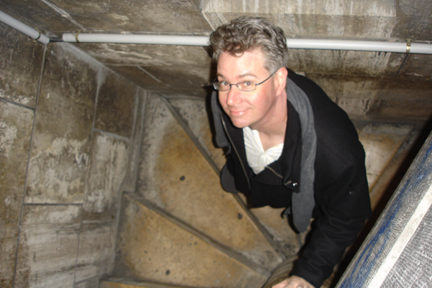
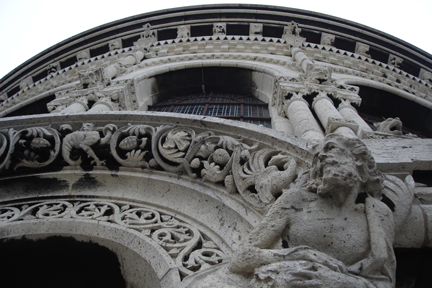
We made it up the main steps and averted to the side where the entrance to both the crypt and the dome are located. Instead of a person there, there is a machine. A french couple in front of us were so completely unable to figure out the machine or willing to give it a go that I finally got a bit frustrated and as soon as they sidestepped, went in to figure this out. It has always been a source of irritation to me how I feel like it's usually up to me to problem solve, since nobody else seems to step up to the plate, but I loose some respect for folks who can't seem to just go for it and figure things out. Just do it. I did. And gee, it was all quite simple. You touch the screen. It asks you what language you prefer. You select one ticket for the dome and the crypt. You feed it your 5 euros, it will make change if you need, and it spits out a ticket. Also simple, the big metal turnstile to the left seems to be the obvious locale for the newly minted ticket, so over I went and stuck the ticket into the turnstile, which ate it, then spit it back out at me. I took this as the sign that all was right with the turnstile Gods, and I pushed through it. It let me into the narrow stone circular stairwell to the dome.
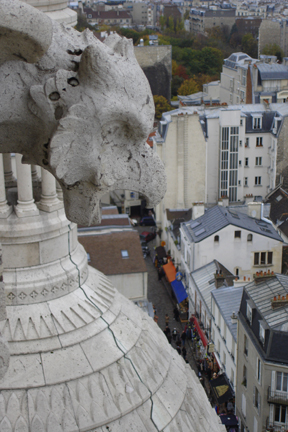
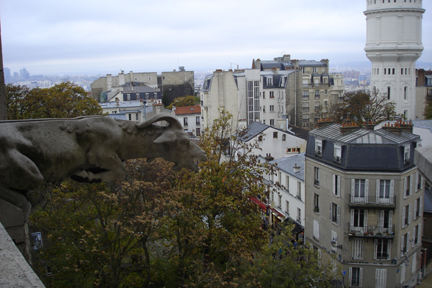
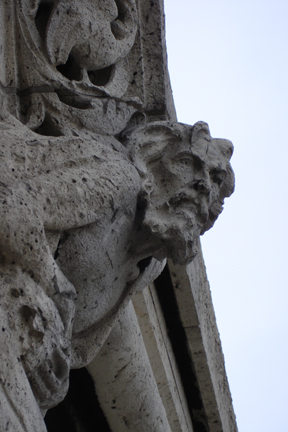
There are a lot of steps to the dome. Lots. I actually managed to get up without stopping, but halfway through I heard this high-pitched wheezing noise and realized it was my lungs, for the first time in many years. I went here with Lara and did the "roof walk" as I had been calling it in 97 and as I talked about before, lost the film to improper loading. This time I had the trusty point and shoot digital, which takes such great pictures it didn't make me miss lugging around a huge and very expensive piece of equipment which yeah, takes great pictures, but comes at the cost of convenience, risk of targeting one's self as tourists and someone who can be pick pocketed and swindled, and nowadays a sore neck. I felt very sanctimonious about the "art" of photography and mostly about my completely manual SLR (not even a battery, thank you very much!) and the skill involved in my shots, then I felt like I was betraying my art by going digital. And in the worst way: the point-and-shoot. It's like going from foie gras to a big mac. Ugh. Now I kind of feel okay with my little camera. The convenience factor is not to be downplayed- when one travels with a map, some money, and the necessary items to manage a foreign country (and despises carrying anything like a purse!) the phone-sized little camera is amazing. And discreet, too- you can snap and be pretty sneaky about it. I still take really great photographs, and that's because I have a good eye and I still think I have some artist in there. And the digital is pretty true to the lens- it takes what I point at, and I still need to edit almost not at all, getting back to Shelby-as-an-artist. Thank you very much.
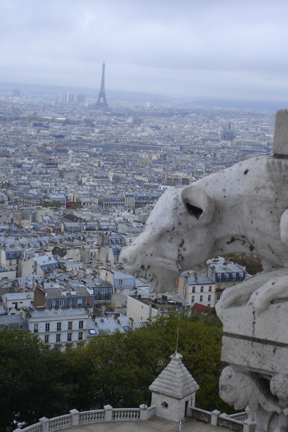
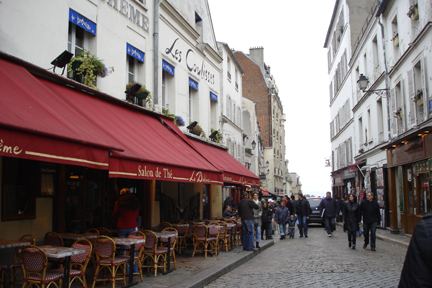
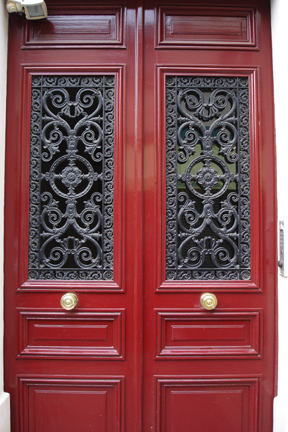
We did the dome walk, which was fabulous, and has these amazing sweeping views of Paris visible through stone arches in 360 degrees pretty spectacular. Inside the church it's also pretty beautiful, it's not italian rococo like you're expecting, it's a little less ornamented and more understated than you think it will be. Pretty enough. We exited Sacre-Coeur to the streets of the Montmartre, and came upon a little square outside of the church packed with crazily overpriced cafes and artists selling some mediocre artwork. Still very, very charming, though. We wound through the hillside streets of the montmarte, some of my favorite in all of Paris, and saw the way the locals "do" life: there were huge lines in front of some of the shops with Parisians getting their foodstuffs for the day: the boulangerie (butcher), the fromagerie (cheeses), patesserie (bakery), and the poissonier (fishmonger). This and little store fronts with the usual suspects, a bunch of food stalls, cafes everywhere the eye looks, epeceries (grocery sellers, all fresh, not like we know them), goods shops, and the expected tourist shop nestled in there as well. We wandered and wandered down the beautiful parisian streets, all with medieval cobblestones underfoot, passing people walking their dogs, everyone carrying the stereotypical baguette under their arms, sitting in cafes drinking coffee and smoking (many with their dogs, of course). Parisian Life. We even passed a 4 piece band of middle aged men playing the most wonderful music on our way through the alleys. They were fantastic! I couldn't believe my luck, walking around Paris on this wonderful afternoon immersed in Parisian "real" life, with this band playing in the street. A saxophone, a banjo, a sousaphone, and a clarinet player. I loved them. We have a little video clip of them that Larry took: listen to it here.
 The
architecture in Paris is, well, Parisian. It's like nothing else I've seen before
in the world. Larry said once when we were wandering around "In London,
there are row houses and building after building, and maybe every few of them
there's one that is really beautiful, but here, every one of these building
is just so beautiful." It's true. they all have these wrought
iron deco-designed regency-esque little faux balconies that I would suppose
allow you to open your french windows without worrying that the kids or the
dog are going to fall out of the 12th story open window. Many have added flower
pots planted with ivy and gorgeous colorful blooms adding big splashes of color
and green to the taupe and iron facades. The street-level is usually filled
with cafes and shops.
The
architecture in Paris is, well, Parisian. It's like nothing else I've seen before
in the world. Larry said once when we were wandering around "In London,
there are row houses and building after building, and maybe every few of them
there's one that is really beautiful, but here, every one of these building
is just so beautiful." It's true. they all have these wrought
iron deco-designed regency-esque little faux balconies that I would suppose
allow you to open your french windows without worrying that the kids or the
dog are going to fall out of the 12th story open window. Many have added flower
pots planted with ivy and gorgeous colorful blooms adding big splashes of color
and green to the taupe and iron facades. The street-level is usually filled
with cafes and shops.
We stopped for a coffee after walking past the building on
the right in the photo, I had to use a restroom or it was going to get ugly
and I tried to get into one of the public Parisian street toilets that we now
have in San Francisco, but found one locked and not accessible unless you're
handicapped (they must give them all a special key that is issued with the 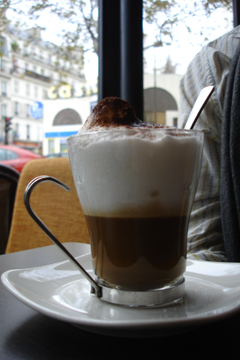 wheelchair
since no where on this metal structure was there a place to either pay, or to
open the rotten door) and found the one that did open so gross inside that there
was no way I was going to brave that. We opted for a cafe, where Larry got a
cappuccino and a crepe filled with chestnut cream and I ordered something called
a "grand creme" which ordered specifically because I assumed I was
going to get the beverage that turned out to be Larry's cappuccino.
wheelchair
since no where on this metal structure was there a place to either pay, or to
open the rotten door) and found the one that did open so gross inside that there
was no way I was going to brave that. We opted for a cafe, where Larry got a
cappuccino and a crepe filled with chestnut cream and I ordered something called
a "grand creme" which ordered specifically because I assumed I was
going to get the beverage that turned out to be Larry's cappuccino.

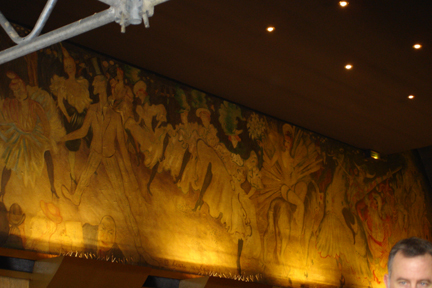
We walked along one of the main streets in the montmartre, passing the Moulin Rouge, the first of the famous red-light cabarets and shows still littering up the area. If you head east, there are lots more of these sex shops and smut shows, we headed west instead toward the Montmartre cemetery which both Larry and I were excited to see. In it are several famous Parisians, dead of course, among them Edgar Degas, Dalida, this famous singer that did a version of "A Taste of Honey" that only a gay man or a fanatical collector of versions of this particular song would know, like Larry. Also in there are Alexandre Dumas, Jean Focault, Vaslav Nijinsky, and Alfred de Vigny, among others. It's stuffed into the already stuffed Montmartre, and there is a bridge carrying both cars and pedestrians over the top and through of the cemetery, with the ancient graves not seeming to mind. They are really packed in there like most of the french and english cemeteries I've been to, and there were about 5 resident cats that we saw lurking around the headstones (although in Paris they love their sepulchers). Larry, pleasantly, likes cemeteries as much as I do, so we spent an hour (or maybe more) wandering around in there. Dalida's grave was an unexpected and pleasant surprise for him- apparently she was Egyptian-born but moved to Paris and was a singer, an actress and a composer of some fame and a big enough cult following. As I said, this cult seems to chiefly be confined to gay men and those who collect wildly obscure versions of the same song, such as Larry Barden.
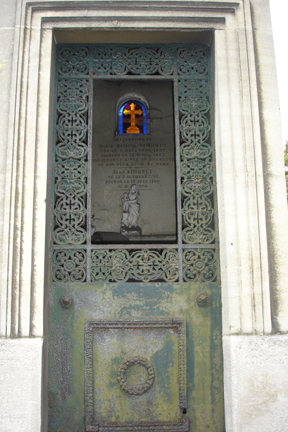
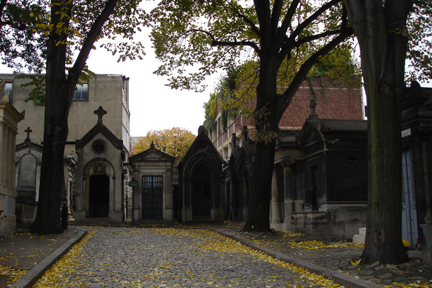
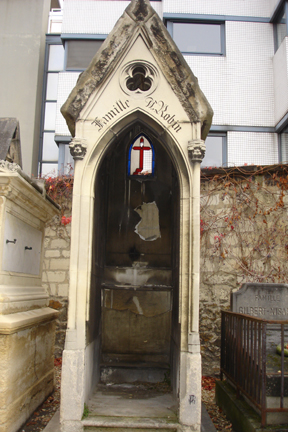
Exiting the cemetery, we walked around some more to find a metro station. Down one of the main arteries of the montmartre, we were lead to a metro station in the middle of an island where about 20 lanes of Parisian traffic come together, we got on the train and headed out for the Il de la Cite and Notre Dame.
Notre Dame cathedral is located on a small island in the middle of the Seine on which the original Medieval city of Paris was located. When it got bigger, they branched out to the banks of the other sides of the Seine as well, leaving us with what is now metropolitan Paris- a very large sprawling city 33 square miles in size. The cathedral was started in 1163 on an edict by Pope Alexander III (whose guilt bridge is a lasting memento to his humility and sense of austere style a couple of pages back- the one with the bride). It was built in the new Gothic Style, using flying buttresses, one of the very first cathedrals in the world to do so. It had thinner walls which allowed them to be higher, and the buttresses supported the weight and the height. It suffered a great deal of desecration in the 1790s during the French Revolution, when many of its religious icons and statues were completely destroyed. It underwent an extensive restoration project in the 1800s restoring it to its pre-revolutionary state.
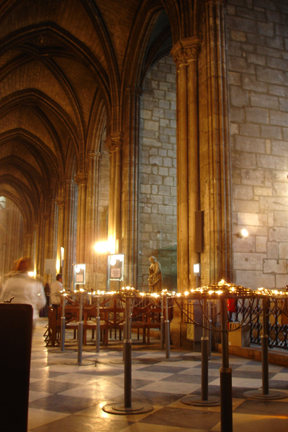
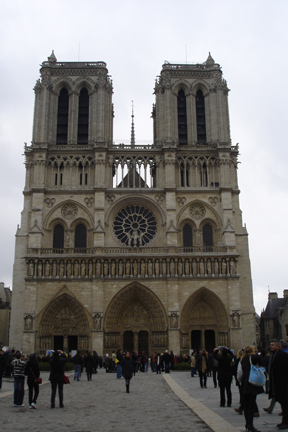
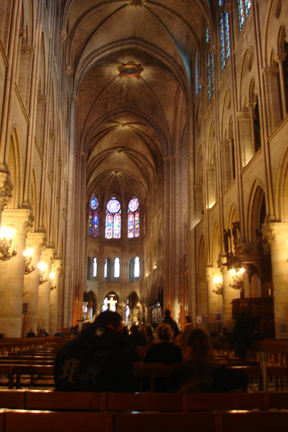
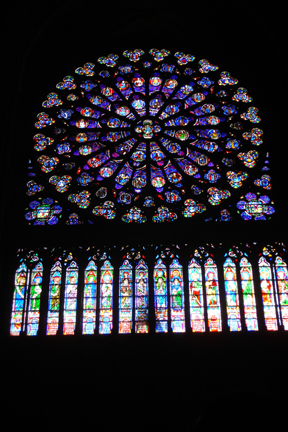 The
rose window which is shown here was completed in 1240s. It's still this colossal
thing, in most highest of high gothic styles that dominates the city with its
stories, and its legends and its history and its amazingness. Larry wasn't immune
to its lure- he was practically skipping around the cathedral like a kid in
a candy store, snapping pictures along with me.
The
rose window which is shown here was completed in 1240s. It's still this colossal
thing, in most highest of high gothic styles that dominates the city with its
stories, and its legends and its history and its amazingness. Larry wasn't immune
to its lure- he was practically skipping around the cathedral like a kid in
a candy store, snapping pictures along with me.
Larry sprung to get us into the Sacristy, which holds all Notre Dame's riches, many of which are not even on display in here. The architecture is still the usual style, you're in this little back alcove set of rooms in the cathedral and I've never been in the sacristy museum before so it was really cool to see this stuff.
Medieval churches made their living by either being catholic, and taxing catholics, or by pilgrims coming to the church on some kind of holy journey. This was very common in the medieval period when churches would pay out millions in both money and blood to collect reliquaries of saints or persons somehow holy and connected to Christ. There was brisk business in reliquaries in the medieval period- the closer you got to christ the more valuable the reliquary was, someone like Louis IX the who paid the equivalent of millions and millions of dollars for what is said to be a relic of the "true cross" (housed in Notre Dame) and the crown of thorns (housed in Saint Chapelle). This place had the added bonus of being the parish church of the french kings, along with Saint Chapelle (for their private worship), and did well for itself.
In the museum were unbelievable works of artistry- things dating from the 12th century like the cathedral itself- countless reliquary boxes with phalanxes and femurs of saints and sinners (or some poor dead guy who was plausibly sold as a saint, more likely- as I said the trade in reliquaries is legendarily shady and involves more than gruesome tales of body digging and the likes). How do you think they got hold of things like the "foreskin" of the baby Jesus? I saw one in the Cluny today that supposedly housed the "umbilical cord" of Jesus. How is that even possible? Mary, alone in a manger with some cows and chickens gives birth to a baby with nobody around other than Joseph (and really, how helpful would a man really have been here? We all know he was probably out sipping beer someplace while she was doing all the hard work of delivering a baby, people) and the breath of God to assist her? Somehow, someone, by mystical possibility would have been there with the foresight to know 1. this is the birth of Christ, 2. I need to help this woman deliver said Christ so that I can 3. save a snippet of the blood, umbilical cord or placenta of the Christ for safe keeping? Not just 30 years from now, but centuries when one could go out into the holy land with a band of trusty knights templar or crusaders at one's side to collect these artifacts from the divine familiars who kept them for centuries so that when Louis IX came looking for them, willing to kill hundreds of people and shell out millions upon millions of dollars for them we can see how suddenly the market was flooded with shriveled bits of tissue purporting to be what they are today. And who knew? No DNA testing then and even today, what would you possible be able to compare it to?
Inside
of the base of this gold structure, which is solid gold and topped with a splendid
solid gold cross, crusted with precious beads and stones is supposedly a piece
of the "true cross." The reliquary business was well known to be somewhat
less than reliable for obvious reasons and a famous quotation by John Calvin
(paraphrased of course) that there were so many bits along with huge pieces
of timber coming over from the Holy Land purporting to be the true cross that
no church was insignificant enough to be left in the dust should they be able
to pay in the dispersal of these relics.
I also saw an interesting and extremely disturbing depiction in the Cluny on a painted 12th century altarpiece a crucified and dead christ, being pulled down from the cross by loyal followers aimed at cleaning him up and giving him a proper burial, a pope was on his knees in front of this bloodied, dead, broken and naked body (with a small wrap for modesty, of course), and the pope was wearing his popely robes which were finely embroidered all over, coat, capelet, tall crown all encrusted with finery and jewels, sewn with gold thread. So rich, in fact, that as he knelt in front of this son-of-a-carpenter's corpse he required two abbots to help carry his finery as he worshiped. I found this depiction quite sage to putting a finger on my distrust of this organization, religion, specifically catholicism, which was born for the sake of power, just like all kings and monarchies and caused just as much war, strife and excuse for the exploitation of the human species on its quest for power, not holiness. I thought the simple, elegant message that all of us are created equal and should be treated with equality, equanimity and love was the whole point. What is true is that that is the real mystical paradox.
Religion aside: we exited Notre Dame and walked along the banks of the Seine and the Ile de la Cite back to metro Paris in the general direction of where I was hoping we would find a metro station which would be convenient to the Eiffel Seine. We wandered and found, to my great satisfaction, that although our feet were so tired and aching, it was just too Parisian and too beautiful and quaint to go back just yet... We walked past an alley with some wrought iron gates and both of us looked in at the same time, seeing the adorable little facades spilling out onto the cobblestones and the adorable signs of the adorable businesses, we both had to just merely glance in the direction of the other, both of us muttering "yah" at the same time and mutually aimed into the alley. I have no idea what the name of the street was, or where in the world it's located in Paris, but we found the cutest little alley in all of Paris for sure...
 Ah!!!
No- in the picture I see it- the cutest alley in all of Paris is in the Latin
Quarter, and it's where Le Procope, the
famous brasserie is located and it's on the right there in my photo...
Ah!!!
No- in the picture I see it- the cutest alley in all of Paris is in the Latin
Quarter, and it's where Le Procope, the
famous brasserie is located and it's on the right there in my photo...
We went back to the hotel and I really, really wanted Indian food since we left London, so we had the idea we'd be able to just find a place here. No such luck. We left the hotel after a break hoping that would help my feet (it did, but not completely), and ended up walking way too far. I was finally so frustrated with this wandering technique that we ate at a Thai place not far from the hotel in the back streets of local Paris for dinner. We split a carafe of the house red, which was more like cote-du-rhone flavored water than wine, split the chicken satay and an order of fresh spring rolls, and I got some pad thai and Larry had the red curry with duck, both of which were really good. We split at 7:47pm and walked as fast as we could back toward our hotel and across the Bir-Hakeim bridge so we could see the 8pm light show at the Eiffel Tower.
We made it. Across the bridge, in a good spot very close to front-on to see the light show for all fantastic 12 minutes it went on. Larry took a video of the whole thing, actually, which is amazing that one person can hold their arm out like that for 12 minutes- if you'd like to see it. Otherwise, a few parting pictures for today's page of the shimmering spectacle.
